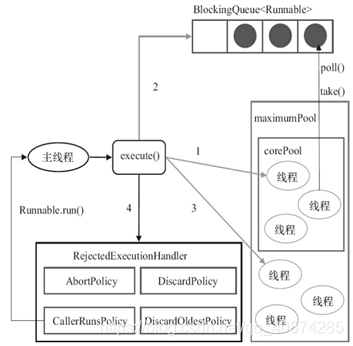线程池存在的意义
平常使用线程即new Thread()然后调用start()方法去启动这个线程,但是在频繁的业务情况下如果在生产环境大量的创建Thread对象是则会浪费资源,不仅增加GC回收压力,并且还浪费了时间,创建线程是需要花时间的;
线程池的存在就是降低频繁的创建线程,降低资源的消耗以及创建时间的浪费,并且可以同一管理。
ThreadPoolExecutor
在JDK中所有的线程池的父类就是ThreadPoolExecutor,以下是它的构造方法
/*** Creates a new {@code ThreadPoolExecutor} with the given initial* parameters.** @param corePoolSize the number of threads to keep in the pool, even* if they are idle, unless {@code allowCoreThreadTimeOut} is set* @param maximumPoolSize the maximum number of threads to allow in the* pool* @param keepAliveTime when the number of threads is greater than* the core, this is the maximum time that excess idle threads* will wait for new tasks before terminating.* @param unit the time unit for the {@code keepAliveTime} argument* @param workQueue the queue to use for holding tasks before they are* executed. This queue will hold only the {@code Runnable}* tasks submitted by the {@code execute} method.* @param threadFactory the factory to use when the executor* creates a new thread* @param handler the handler to use when execution is blocked* because the thread bounds and queue capacities are reached* @throws IllegalArgumentException if one of the following holds:<br>* {@code corePoolSize < 0}<br>* {@code keepAliveTime < 0}<br>* {@code maximumPoolSize <= 0}<br>* {@code maximumPoolSize < corePoolSize}* @throws NullPointerException if {@code workQueue}* or {@code threadFactory} or {@code handler} is null*/public ThreadPoolExecutor(int corePoolSize,int maximumPoolSize,long keepAliveTime,TimeUnit unit,BlockingQueue<Runnable> workQueue,ThreadFactory threadFactory,RejectedExecutionHandler handler) {if (corePoolSize < 0 ||maximumPoolSize <= 0 ||maximumPoolSize < corePoolSize ||keepAliveTime < 0)throw new IllegalArgumentException();if (workQueue == null || threadFactory == null || handler == null)throw new NullPointerException();this.corePoolSize = corePoolSize;this.maximumPoolSize = maximumPoolSize;this.workQueue = workQueue;this.keepAliveTime = unit.toNanos(keepAliveTime);this.threadFactory = threadFactory;this.handler = handler;}int corePoolSize :线程池中核心线程数,小于corePoolSize ,就会创建新线程,等于corePoolSize ,这个任务就会保存到BlockingQueue,如果调用prestartAllCoreThreads()方法就会一次性的启动corePoolSize个数的线程。
int maximumPoolSize: 允许的最大线程数,BlockingQueue也满了,小于maximumPoolSize时候就会再次创建新的线程
long keepAliveTime:线程空闲下来后,存活的时间,这个参数只在大于corePoolSize才有用
TimeUnit unit:存活时间的单位值
BlockingQueue<Runnable> workQueue:保存任务的阻塞队列
ThreadFactory threadFactory:创建线程的工厂,给新建的线程赋予名字
RejectedExecutionHandler handler:饱和策略
AbortPolicy :直接抛出异常,默认;
CallerRunsPolicy:用调用者所在的线程来执行任务
DiscardOldestPolicy:丢弃阻塞队列里最老的任务,队列里最靠前的任务
DiscardPolicy :当前任务直接丢弃
也可以实现自己的饱和策略,实现RejectedExecutionHandler接口即可
实现基本原理
主要是依赖BlockingQueue<Runnable>队列和HashSet<Worker>实现的,Worker继承了Runnable以及AQS的一个内部类,所以这个类具体等待并且开启线程的功能
在提交Runnable可执行的线程时,
当前线程数小于corePoolSize 的时候,仅仅是将Runnable添加到HashSet<Worker>当中,并且执行start()方法,调用的是runWorker()方法
当前线程数大于或等于corePoolSize 的时候,会将Runnable添加到workerQueue队列中等待并且会添加一个null的Runnable到addWorker()方法当中。如果队列满了offer失败就会执相应的reject拒绝策略。
public void execute(Runnable command) {if (command == null)throw new NullPointerException();/** Proceed in 3 steps:** 1. If fewer than corePoolSize threads are running, try to* start a new thread with the given command as its first* task. The call to addWorker atomically checks runState and* workerCount, and so prevents false alarms that would add* threads when it shouldn't, by returning false.** 2. If a task can be successfully queued, then we still need* to double-check whether we should have added a thread* (because existing ones died since last checking) or that* the pool shut down since entry into this method. So we* recheck state and if necessary roll back the enqueuing if* stopped, or start a new thread if there are none.** 3. If we cannot queue task, then we try to add a new* thread. If it fails, we know we are shut down or saturated* and so reject the task.*/int c = ctl.get();if (workerCountOf(c) < corePoolSize) {if (addWorker(command, true))return;c = ctl.get();}if (isRunning(c) && workQueue.offer(command)) {int recheck = ctl.get();if (! isRunning(recheck) && remove(command))reject(command);else if (workerCountOf(recheck) == 0)addWorker(null, false);}else if (!addWorker(command, false))reject(command);}private boolean addWorker(Runnable firstTask, boolean core) {retry:for (;;) {int c = ctl.get();int rs = runStateOf(c);// Check if queue empty only if necessary.if (rs >= SHUTDOWN &&! (rs == SHUTDOWN &&firstTask == null &&! workQueue.isEmpty()))return false;for (;;) {int wc = workerCountOf(c);if (wc >= CAPACITY ||wc >= (core ? corePoolSize : maximumPoolSize))return false;if (compareAndIncrementWorkerCount(c))break retry;c = ctl.get(); // Re-read ctlif (runStateOf(c) != rs)continue retry;// else CAS failed due to workerCount change; retry inner loop}}boolean workerStarted = false;boolean workerAdded = false;Worker w = null;try {w = new Worker(firstTask);final Thread t = w.thread;if (t != null) {final ReentrantLock mainLock = this.mainLock;mainLock.lock();try {// Recheck while holding lock.// Back out on ThreadFactory failure or if// shut down before lock acquired.int rs = runStateOf(ctl.get());if (rs < SHUTDOWN ||(rs == SHUTDOWN && firstTask == null)) {if (t.isAlive()) // precheck that t is startablethrow new IllegalThreadStateException();workers.add(w);int s = workers.size();if (s > largestPoolSize)largestPoolSize = s;workerAdded = true;}} finally {mainLock.unlock();}if (workerAdded) {t.start();workerStarted = true;}}} finally {if (! workerStarted)addWorkerFailed(w);}return workerStarted;}
在addWorker()方法当中,如果Runnable为空的话,会直接返回false,否则将创建一个Worker对象并且启动它,在runWorker中,首先执行完后传输过来的Runnable对象中的run(),然后循环去workerQueue队列使用take方法拿等待队列中的Runnable对象,并且执行相应的run()方法。
final void runWorker(Worker w) {Thread wt = Thread.currentThread();Runnable task = w.firstTask;w.firstTask = null;w.unlock(); // allow interruptsboolean completedAbruptly = true;try {while (task != null || (task = getTask()) != null) {w.lock();// If pool is stopping, ensure thread is interrupted;// if not, ensure thread is not interrupted. This// requires a recheck in second case to deal with// shutdownNow race while clearing interruptif ((runStateAtLeast(ctl.get(), STOP) ||(Thread.interrupted() &&runStateAtLeast(ctl.get(), STOP))) &&!wt.isInterrupted())wt.interrupt();try {beforeExecute(wt, task);Throwable thrown = null;try {task.run();} catch (RuntimeException x) {thrown = x; throw x;} catch (Error x) {thrown = x; throw x;} catch (Throwable x) {thrown = x; throw new Error(x);} finally {afterExecute(task, thrown);}} finally {task = null;w.completedTasks++;w.unlock();}}completedAbruptly = false;} finally {processWorkerExit(w, completedAbruptly);}}关闭线程池的方法:
shutdownNow():设置线程池的状态,还会尝试停止正在运行或者暂停任务的线程
shutdown()设置线程池的状态,只会中断所有没有执行任务的线程
工作机制

合理配置线程池
根据任务的性质来:计算密集型(CPU),IO密集型,混合型
计算密集型:加密,大数分解,正则……., 线程数适当小一点,最大推荐:机器的Cpu核心数+1,为什么+1,防止页缺失,(机器的Cpu核心=Runtime.getRuntime().availableProcessors();)
IO密集型:读取文件,数据库连接,网络通讯, 线程数适当大一点,机器的Cpu核心数*2,
混合型:尽量拆分,IO密集型>>计算密集型,拆分意义不大,IO密集型~计算密集型
队列的选择上,应该使用有界,无界队列可能会导致内存溢出
Executors预定义的线程池
FixedThreadPool:创建固定线程数量的,适用于负载较重的服务器,使用了无界队列
SingleThreadPoolExecutor:创建单个线程,需要顺序保证执行任务,不会有多个线程活动,使用了无界队列
CachedThreadPool:会根据需要来创建新线程的,执行很多短期异步任务的程序,使用了SynchronousQueue
WorkStealingPool(JDK7以后): 基于ForkJoinPool实现
Executor框架

还有一个是定时器,待会儿再说吧
















)
![bzoj4152-[AMPPZ2014]The_Captain](http://pic.xiahunao.cn/bzoj4152-[AMPPZ2014]The_Captain)

